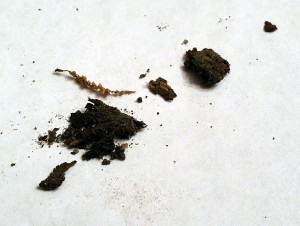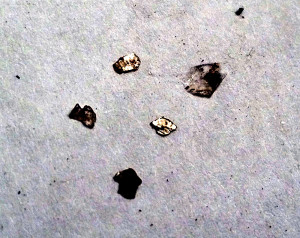The focus of our research methods class is a semester-long project to get “under the surface” of an object to explore both its origins and its implications. I was inspired by an article by Michael Pollan to take a closer look at something that I have always found fascinating: dirt.
I began by compiling a list of the ideas and connections that I can currently see: sort of a “before” snapshot to capture where I’m starting the research process. Borrowing from the concept maps we’ve been doing for Design Theory, I chose that format for my outline.
The experimentalist in me wanted to get in and get my hands dirty, and the gardener in me can never resist playing in the dirt, either. A soil sample collected in January is certainly not the most representative one, but I scraped what I could from the frozen ground in my garden and spent yesterday poking through it to see what I might find.
The sample was collected from my back yard, which was a dense clay with almost no organic content when we moved into the house 3 1/2 years ago. The landlords had given up on trying to grow grass in the back yard, and had laid down astroturf instead.
When we moved in, we removed the astroturf and started the process of rebuilding the soil. We added compost, peat moss, and began planting in a raised bed. Since then, every year I have mixed in some of the leaves that fall from the maple tree in our yard, and we continue to plant every spring. Many of the plants are perennials, but I let the annuals die in place over the winter and pull off just the dead tops of the plants in spring. This leaves the root matter behind, which helps to give both structure and organic content to the soil. I also mix old mulch from previous years into the soil before adding a fresh layer each spring.
The ground is currently frozen solid, so I was only able to chip off the upper surface layer of dirt from beneath my layer of weed block fabric. The sample was collected from the top inch of dirt, from three different locations in the garden.
I collected about a half a cup of dirt, which weighed 86 grams.

I spread it out on a piece of paper, and began manually separating out the different components. The smell of thawing soil is the smell of spring, so it was wonderful to do this activity on a snowy day in January.

As the soil thawed, it also began to dry out. You can get an idea of how much water was in the soil by how much the paper warped. As I sorted, I found the following:
- 1 creepy crawly (I’m sure that’s the technical term)

- 1 earthworm hatchling (I seem to have forgotten to take a photo of that one)
- 2 seeds

- bits of leaves and maple seed casings

- bits of dried moss

- a few bits of plant root

- roughly 11 pine/spruce needles

- 5 tiny chips of mica

- a collection of pebbles

- lots of mulch
- a few bits of manmade trash: a piece of black plastic, a square of gold foil, and a roll of something that might be electrical tape

After sorting out all of the various components, I put them in the oven at 170 degrees (F) for about an hour and a half to drive off the remaining water. (The creepy crawly and the earth worm did not appear to have survived the excavation/soil thaw, but I decided not to bake them, just in case they were still alive.)

None of the smaller items were heavy enough to register on the scale, so I only measured the dry weight of the main soil components. I used a kitchen sieve to separate the fine clay soil from the smaller rock and mulch particles, and measured those in their own category since they were too small to sort by hand. Going clockwise from 12:00, the pie chart below shows the various quantities of: clay/fine rock particles (37%), water (35%), rocks (13%), fine mulch/rock particles (7%), and mulch (7%).

I was surprised at how much water there was – fully a third of the sample was water weight. The mulch certainly makes up a lot of the volume, but its density is so low that it’s only 7% of the total weight. The mineral and rock components make up most of the weight of the sample, as you’d expect.
I know from experience that a similar soil sample taken in August would have a lot more creepy crawlies, several earthworms, a few grubs, and probably one or two ants. There would probably be some soil mites, a few beetles, and maybe a spider or two hiding under the mulch near the surface. If I had dug deeper in collecting it, I could also expect to find more plant roots and tiny white lines of fungus trailing through the dirt. This little sample would be a busy place, if I hadn’t chosen to measure it in the middle of winter.
And then, in addition to all of the living things that I can see, there are also plenty that I can’t. The microbial world in the soil is really the most fascinating place, because that’s where the magic happens. Fungi, bacteria, and a host of other “simple” life forms make up the rich ecosystem responsible for turning rocks and dead plant material into a vibrant, living, and life-giving thing.
Because the microbes are so tiny, I’ll have to rely on science to tell me what’s really going on in there, at a scale smaller than my eyes can detect. Fortunately, a recent gene-sequencing technology has allowed all kinds of studies of microbial systems that wouldn’t have been possible before. The whole-genome technique allows scientists to take a sample from a mixed system (like soil) and simultaneously sequence all of the genomes inside of it. Instead of having to isolate each organism in a laboratory culture to identify it, they can just look at everything at once. This is particularly exciting because many very important microorganisms can’t be grown in the lab, and could not previously be studied. This new technique opens up the possibility of taking a single snapshot of all of the organisms in a sample at one time, and will give a much more comprehensive overview of what’s going on in the ecosystem of interest. This method is being used in all kinds of studies that weren’t possible before, and may change the way we view bacterial cultures entirely.
In this project, I’m interested not only in looking at what ends up in the soil in my backyard, but also how it is broken down by the creatures that inhabit the soil, and the implications that has for my garden, for the environment, and for the planet as a whole. I have a feeling that I will find what gardeners have always suspected: the fate of the whole world is contained in that one handful of dirt.











